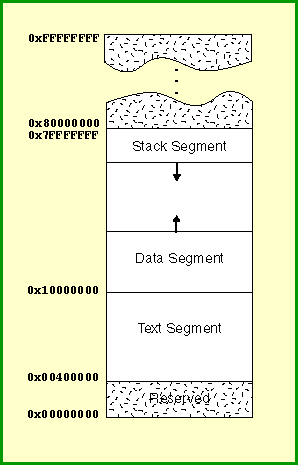Storage Classes

There are three places in memory where data may be placed:
in the data section
(declared with .data in assembly language),
on the run-time stack,
and on the heap.
A subroutine other than main()
can have data in the .data section.
In high-level programming languages, such as "C",
this type of storage is called static.
Variables whose storage is allocated on the run-time stack are (sometimes) called automatic variables. This is because their storage is "automatically" pushed and popped as a subroutine is entered and exited. Usually the word "variable" means "automatic variable".
A variable whose memory is located in the heap is called
a dynamic variable.
These notes only briefly deal with the heap.
The heap is where memory for objects is found
(using the new operation in Java or C++).
In "C" dynamic memory is allocated using the malloc
operation (or similar).
The heap is on top of the data segment. As dynamic variables are created it grows upward (towards the stack)